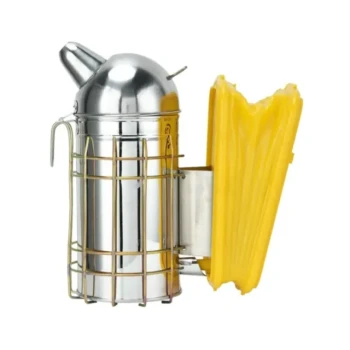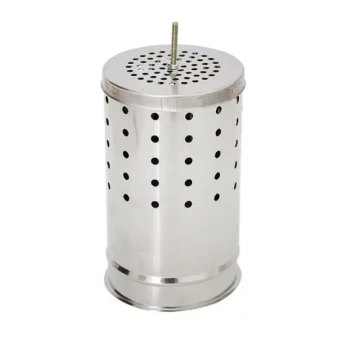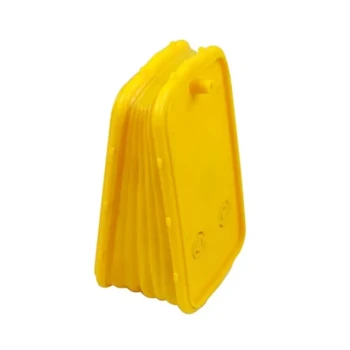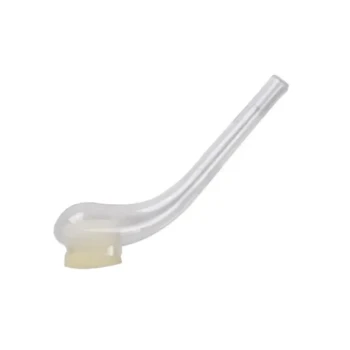To use a bee smoker effectively, your goal is moderation and communication, not fumigation. The best technique involves using just enough cool, white smoke to mask the bees' alarm pheromones and gently direct their movement, starting with a few puffs at the hive entrance a minute before you open it. This light touch keeps the colony calm and the inspection productive.
Your smoker is a communication tool, not a weapon. Its purpose is to gently interrupt the bees' alarm signals, encouraging them to remain calm. Mastering its use is about understanding bee behavior and applying the minimum effective amount to achieve a peaceful inspection.

The Principle: Why Smoke Calms Bees
Before you can master the technique, you must understand why smoke works. It leverages two of the bees' ancient, instinctual responses.
Masking Alarm Pheromones
When a bee feels threatened or is injured, it releases an alarm pheromone (isoamyl acetate), which smells like bananas. This chemical alerts other guard bees to the potential danger, putting the colony on high alert.
Smoke effectively masks this pheromone, preventing the signal from spreading throughout the hive. Without this chemical trigger, a chain reaction of defensive behavior is far less likely to start.
Triggering a Feeding Response
Smoke also triggers a deep-seated survival instinct related to forest fires. When bees sense smoke, their first impulse is to prepare to abandon the hive.
To do this, they rush to the nearest honey cells and engorge themselves on honey, stocking up on resources for the potential journey. A bee with a full belly is physically less able to flex its abdomen to sting, making it more docile.
Mastering the Technique: A Step-by-Step Guide
Effective smoking is a practice of finesse. From lighting the fuel to applying the smoke, every step matters.
Preparing the Perfect Smoke
The quality of your smoke is critical. You want cool, thick, white smoke, never hot, grey, or acrid smoke with visible sparks.
Start by lighting a small amount of fast-burning tinder (like pine needles, dry grass, or newspaper) at the bottom of your smoker. Once it's lit, gently pump the bellows until you have a small, steady flame. Gradually add your primary, slower-burning fuel (such as pine cones, wood pellets, or burlap) and continue puffing until it is smoldering well.
The Initial Approach
Your work begins before you even crack the lid. Approach the hive and direct two or three gentle puffs of smoke into the main entrance.
Wait for 60-90 seconds. This gives the smoke time to circulate and allows the bees to begin their feeding response, setting the stage for a calm inspection.
Applying Smoke During the Inspection
Once you remove the outer and inner covers, apply a few gentle puffs of smoke across the tops of the frames. This pushes the guard bees down and keeps the colony's mood subdued.
As you work through the hive, use smoke sparingly and only as needed. If you notice bees starting to line up on top of a frame and face you, this is a signal to give them another small puff of smoke.
Using Smoke to Direct Bee Traffic
Smoke is also a physical tool. If you need to inspect the edge of a frame or prevent bees from being crushed when you replace a frame, you can use a puff of smoke to gently herd them out of the way.
Understanding the Trade-offs and Common Mistakes
Improper smoker use can create more problems than it solves. Knowing the pitfalls is key to avoiding them.
The Danger of Over-smoking
More is not better. Using too much smoke will not make the bees calmer; it will agitate them, impair their respiratory systems, and can even contaminate honey and wax with a smoky flavor.
If you find yourself needing to puff the smoker constantly, it's a sign that the bees are overly agitated.
Reading the Colony's Mood
Your smoker is not a magic wand. If the bees remain highly defensive despite calm and moderate smoking, it may be due to other factors like poor weather, a recent disturbance, or the colony's genetics.
If you are constantly re-smoking to keep bees at bay, it is a sign that you should end the inspection. Close the hive calmly and plan to return on a better day.
Avoiding Hot or "Dirty" Smoke
Always test the smoke on the back of your hand before pointing it at the hive. It should be warm, not hot.
Keep the smoker at least 5-8 inches away from the bees to avoid burning their delicate wings. If you see sparks or thin, grey smoke, your fuel is burning too hot or is not the right material.
How to Apply This to Your Inspection
Your approach to smoking will vary slightly based on the colony and your goals for the day.
- If your primary focus is a routine health check: Use minimal smoke. A few puffs at the entrance and one or two across the top bars are often all you need for a gentle colony.
- If you are working with a known "hot" or defensive hive: Be prepared to use slightly more smoke, but work quickly and efficiently to minimize the disturbance.
- If you are harvesting honey or requeening: Use smoke purposefully to drive bees down from the honey supers or away from an area where you need to work undisturbed.
Ultimately, using a smoker is a conversation with your hive, and becoming fluent requires practice and observation.
Summary Table:
| Tip Category | Key Action | Purpose & Benefit |
|---|---|---|
| Smoke Principle | Masks alarm pheromones & triggers feeding | Calms bees by disrupting defensive signals and making them docile. |
| Preparation | Use slow-burning fuel (e.g., pine cones) | Creates cool, thick, white smoke that is safe and effective. |
| Application | 2-3 puffs at entrance, wait 60-90 seconds | Gives bees time to react calmly before you open the hive. |
| During Inspection | Use sparingly across frame tops | Gently directs bee movement and subdues the colony's mood. |
| Common Mistake | Avoid over-smoking and hot sparks | Prevents bee agitation, respiratory issues, and honey contamination. |
Ready to Elevate Your Beekeeping Practice with Professional-Grade Equipment?
Mastering your smoker technique is just the beginning. Equip your apiary with the reliable, high-performance supplies that commercial beekeepers and distributors trust. HONESTBEE provides a comprehensive wholesale range of essential beekeeping equipment—from durable smokers and protective gear to advanced hive tools—designed to enhance your efficiency and ensure colony health.
Let's discuss your specific needs. Contact our expert team today to explore our wholesale catalog and discover how we can support your operation's growth and success.
Visual Guide
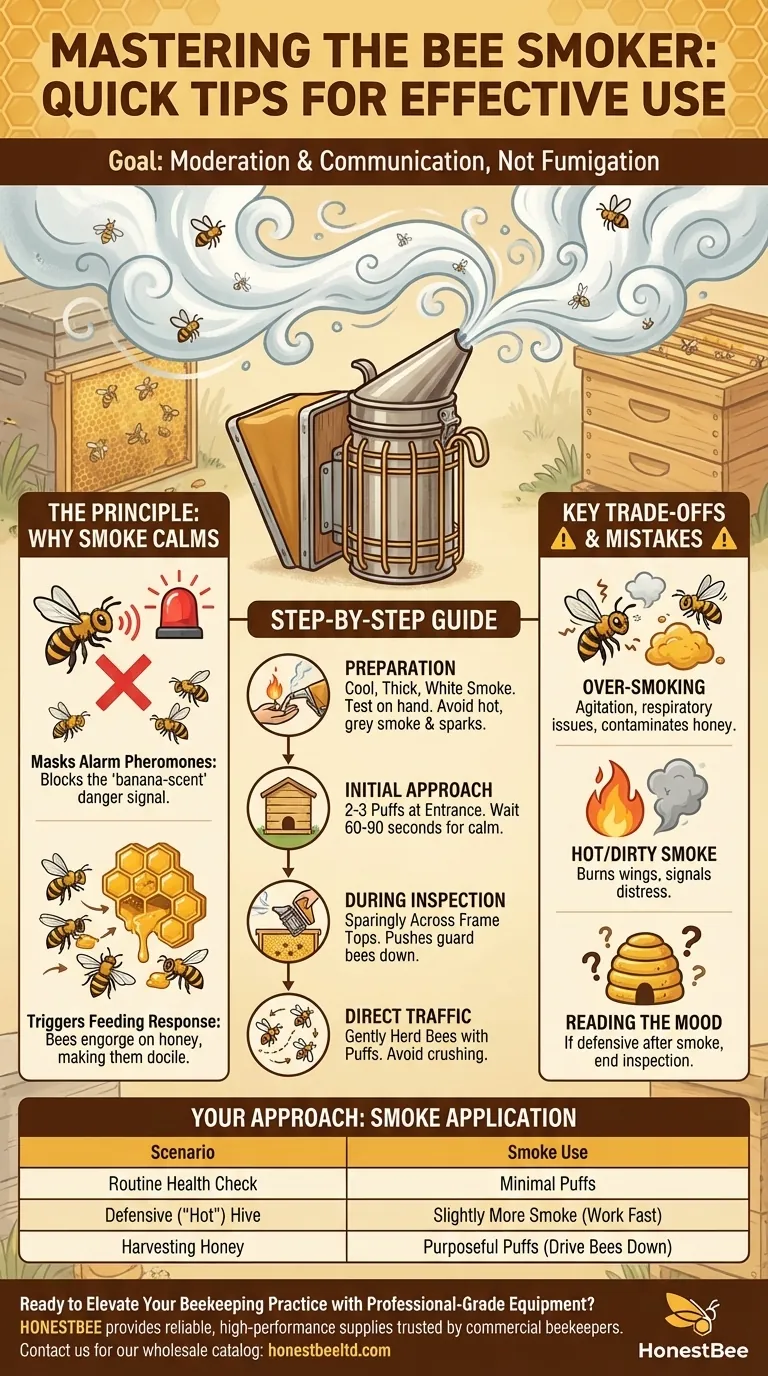
Related Products
- Premium Traditional Copper Bee Smoker with Bellows
- Stainless Steel Honey Bee Smoker Hive and Honeycomb Smoker for Beekeeping
- European Stainless Steel Bee Smoker for Honey Bee Hive
- Stainless Steel Electric Beehive Smoker for Beekeeping and Bee Keeper Use
- Electric Bee Smoker European Style Bee Hive Smoker for Beekeeping
People Also Ask
- What happens to bees when they sense smoke? Unlock the Secret to Calm Hive Inspections
- What is the primary purpose of using smoke in beekeeping? Calm Bees for Safer Hive Management
- What are some alternatives to using smoke in beekeeping? A Guide to Gentle Hive Management
- How does water mist work as an alternative to smoke in beehives? A Guide to Safe & Effective Use
- What is a Smoker and how is it used in beekeeping? The Essential Tool for Calm, Safe Hive Inspections










